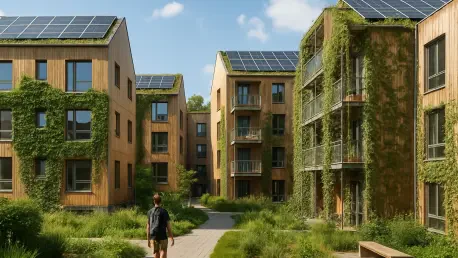Imagine a university city where student housing not only meets the urgent demand for beds but also pioneers a greener, healthier way of living, transforming the urban landscape one building at a time. Across the globe, the call for modern, eco-friendly student accommodations is louder than ever, driven by skyrocketing student populations and a pressing need to combat environmental challenges. Sustainable student housing stands as a critical solution, reducing carbon footprints while fostering student well-being through thoughtful design. This analysis delves into the surging trend of sustainability in student housing, exploring growth patterns, showcasing real-world examples, gathering expert insights, and considering future implications for both students and urban development.
The Rise of Sustainable Student Housing
Growth and Adoption Trends
The demand for purpose-built student accommodation has surged in recent years, reflecting a global student population that continues to expand rapidly. According to industry reports, millions of students worldwide face housing shortages, with many university cities struggling to keep pace. This gap has spurred a significant shift toward sustainable designs, as developers and institutions prioritize green certifications like BREEAM and LEED to meet both environmental and student needs.
Data from recent studies indicates that sustainable student housing projects have seen a marked increase in adoption, particularly in regions like Europe and North America. In Asia, emerging markets are also catching up, with countries investing in eco-friendly infrastructure to attract international students. Reports suggest that over half of new student housing developments in major university hubs now incorporate energy-efficient systems or renewable materials, signaling a profound change in industry standards.
This trend is not merely a response to regulatory pressures but also a reflection of student preferences for living spaces that align with their values. Surveys conducted by university housing associations reveal that a growing number of students prioritize sustainability when choosing accommodations. As this demand shapes the market, developers are increasingly compelled to integrate green practices into their projects, setting a new benchmark for the sector.
Real-World Applications and Case Studies
A prime example of this trend is iQ Longwood Place near the University of Warwick in Coventry, UK, where the first phase, delivering 572 beds, has already been completed. This £100 million project, boasting a BREEAM Excellent rating, exemplifies sustainable innovation with features like recycled demolition materials, smart waste management via platforms like SmartWaste, and protected green spaces. Its amenities, including social hubs, a gym, and landscaped outdoor areas, further enhance the student experience.
Beyond this standout project, other global initiatives are making waves in the realm of sustainable student housing. Developers in North America are constructing energy-efficient dormitories using modular building techniques, while in Europe, some projects incorporate rooftop gardens and solar panels as standard features. These efforts highlight a broader industry movement toward balancing environmental responsibility with modern living standards.
Specific design elements are becoming benchmarks for the field, such as integrated waste sorting systems, communal green spaces, and architecture that harmonizes with natural surroundings. These features not only reduce environmental impact but also foster a sense of community among residents. As more projects adopt such practices, they pave the way for a redefined vision of student living that prioritizes both planet and people.
Expert Perspectives on Sustainability in Student Housing
Insights from industry leaders underscore the importance of sustainability as a core principle in student housing development. Gary Cramp of McLaren Construction, reflecting on projects like iQ Longwood Place, emphasizes that safety, quality, and environmental responsibility are non-negotiable. His perspective highlights how modern construction must align with broader ecological goals to create lasting value for communities.
Further viewpoints from stakeholders reveal a shared commitment to student-centric design through collaboration. William Davies of Topland Group notes that partnerships are vital in delivering accommodations that support students and uplift surrounding areas. Similarly, Matt Loughlin of iQ Student Accommodation stresses the role of community-focused spaces in enhancing comfort and social interaction, pointing to a holistic approach in shaping living environments.
Experts also acknowledge challenges in this evolving landscape, such as the tension between cost and sustainability. Balancing budgets with green initiatives often requires innovative financing or government support, while long-term impacts on urban development remain a topic of discussion. These hurdles, however, are seen as opportunities to refine strategies that benefit both student populations and city planning, ensuring that sustainability remains a priority in future endeavors.
Future Outlook for Sustainable Student Housing
Looking ahead, emerging trends suggest that smart technology will play a pivotal role in advancing energy efficiency within student housing. Innovations like automated lighting, heating systems, and real-time energy monitoring are expected to become standard, reducing utility costs and environmental impact. Additionally, an increased focus on mental health through communal spaces signals a shift toward designs that nurture well-being alongside sustainability.
The potential benefits of these advancements are substantial, ranging from significantly lowered carbon emissions to heightened student satisfaction. However, challenges such as funding constraints and varying regulatory frameworks across regions could slow progress. Addressing these barriers will require coordinated efforts among developers, universities, and policymakers to ensure that sustainable housing remains accessible and scalable.
Broader implications extend beyond student sectors, as these developments could influence urban planning on a larger scale. Sustainable student housing might inspire similar standards in residential and commercial projects, reshaping cityscapes to be more eco-conscious. As this trend gains momentum from 2025 to 2027 and beyond, it holds the promise of setting a precedent for how communities can grow in harmony with environmental goals.
Conclusion and Call to Action
Reflecting on the journey of sustainable student housing, it becomes evident that this trend has gained remarkable traction, driven by urgent demand and a commitment to greener living. Projects like iQ Longwood Place showcase how innovation and environmental stewardship can coexist, while expert insights highlight the transformative power of collaboration. This movement redefines not just student accommodations but also the broader conversation around urban development.
Moving forward, developers and universities must deepen their investment in eco-friendly technologies and designs, ensuring that every new project pushes the boundaries of sustainability. Policymakers, too, play a crucial role in crafting supportive frameworks that ease financial and regulatory challenges. By embracing these next steps, the industry can build on past successes to create living spaces that inspire future generations while safeguarding the planet.









